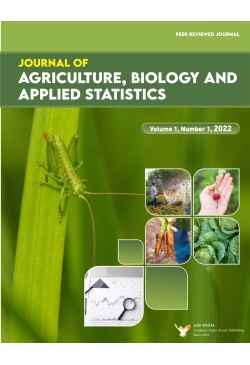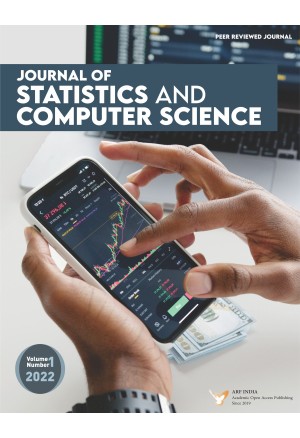MAKE MOST OF THE KNOWLEDGE NETWORK, JOIN ACADEMIC RESEARCH FOUNDATION
JABASJournal of Agriculture, Biology and Applied Statistics

Peer Reviewed Journal
Find out more
Latest Articles :- Vol: (3) (2) (Year:2024)
Forecast of Milk and Eggs Production of India using ARIMA Model
BY: S. R. Krishna Priya and N. NaranammalJournal of Agriculture, Biology and Applied Statistics, Year:2024, Vol.3 (2), PP.47-56
Received: 17 March 2024 | Revised: 11 April 2024 | Accepted: 21 April 2024 | Publication: 30 September 2024
DOI : https://DOI:10.47509/JABAS.2024.v03i02.01
Milk and eggs are the most important sources of nutrition consumed daily in every household in many forms. There is an increase of milk and egg consumption due to the increase in population in India. Per capita consumption of milk and eggs has been drastically increasing over the past decades. Therefore, forecasting milk and egg production is necessary to make a strategic plan for the government. In this study, milk and egg production in India has been forecast using auto regressive integrated moving average (ARIMA) model. Milk and egg production data from year 1950-51 to 2019-20 has been used for the development of the model. Results revealed that ARIMA (2,2,0) and ARIMA (1,2,2) are the best models for forecasting milk and egg production respectively. The ACF and PACF plots of residuals do not have autocorrelation. It implies that the proposed model is the best model for forecasting. Result of the goodness of fit measure, mean absolute percentage error is satisfactory. The production of milk and eggs from years 2020-21 to 2024-25 has been forecasted using the best ARIMA model. From the forecasted value, it is clear that there will be an increasing demand for milk and eggs in the upcoming years.
Keywords: Milk, Egg, ARIMA, Forecasting, Stationarity, Poultry, Dairy, Modelling.
S.R. Krishna Priya & N. Naranammal (2024). Forecast of Milk and Eggs Production of India using ARIMA Model. Vol. 3, No. 2, pp. 47-56. https://DOI:10.47509/JABAS.2024.v03i02.01
Milk and eggs are the most important sources of nutrition consumed daily in every household in many forms. There is an increase of milk and egg consumption due to the increase in population in India. Per capita consumption of milk and eggs has been drastically increasing over the past decades. Therefore, forecasting milk and egg production is necessary to make a strategic plan for the government. In this study, milk and egg production in India has been forecast using auto regressive integrated moving average (ARIMA) model. Milk and egg production data from year 1950-51 to 2019-20 has been used for the development of the model. Results revealed that ARIMA (2,2,0) and ARIMA (1,2,2) are the best models for forecasting milk and egg production respectively. The ACF and PACF plots of residuals do not have autocorrelation. It implies that the proposed model is the best model for forecasting. Result of the goodness of fit measure, mean absolute percentage error is satisfactory. The production of milk and eggs from years 2020-21 to 2024-25 has been forecasted using the best ARIMA model. From the forecasted value, it is clear that there will be an increasing demand for milk and eggs in the upcoming years.
Keywords: Milk, Egg, ARIMA, Forecasting, Stationarity, Poultry, Dairy, Modelling.
S.R. Krishna Priya & N. Naranammal (2024). Forecast of Milk and Eggs Production of India using ARIMA Model. Vol. 3, No. 2, pp. 47-56. https://DOI:10.47509/JABAS.2024.v03i02.01
Forecasting Wheat Crop Area, Production & Productivity in India Using Arimax Model
BY: S. R. Krishna Priya and N. KausalyaJournal of Agriculture, Biology and Applied Statistics, Year:2024, Vol.3 (2), PP.57-68
Received: 19 March 2024 | Revised: 17 April 2024 | Accepted: 27 April 2024 | Publication: 30 September 2024
DOI : https://DOI:10.47509/JABAS.2024.v03i02.02
The Time Series approach has been used in this study to assess the Area, Production, and Productivity statistics of wheat for India. Annual data on Wheat Area, Production & Productivity for a period of 68 years (from 1951 to 2018) has been utilized for the study. The results have been predicted using the Box-Jenkins ARIMA approach and ARIMAX. The appropriate models have been selected based on the low Akaike Information Criteria (AIC) and error measures like Mean Absolute Error (MAE), Mean Square Error (MSE), and Mean Absolute Percentage Error (MAPE) have been used to assess the validity of the models. The results reveal that ARIMAX model with Temperature (1,1,1) & (0,1,1) is most suitable for Wheat Area & Production. For Wheat Productivity data, ARIMAX with Rainfall & Temperature (1,1,1) is found to be most appropriate.
Keywords: ARIMA, ARIMAX, MAE, MSE, MAPE, AIC
S.R. Krishna Priya & N. Kausalya (2024). Forecasting Wheat Crop Area, Production & Productivity in India using Arimax Model. Vol. 3, No. 2, pp. 57-68. https://DOI:10.47509/JABAS.2024.v03i02.02
The Time Series approach has been used in this study to assess the Area, Production, and Productivity statistics of wheat for India. Annual data on Wheat Area, Production & Productivity for a period of 68 years (from 1951 to 2018) has been utilized for the study. The results have been predicted using the Box-Jenkins ARIMA approach and ARIMAX. The appropriate models have been selected based on the low Akaike Information Criteria (AIC) and error measures like Mean Absolute Error (MAE), Mean Square Error (MSE), and Mean Absolute Percentage Error (MAPE) have been used to assess the validity of the models. The results reveal that ARIMAX model with Temperature (1,1,1) & (0,1,1) is most suitable for Wheat Area & Production. For Wheat Productivity data, ARIMAX with Rainfall & Temperature (1,1,1) is found to be most appropriate.
Keywords: ARIMA, ARIMAX, MAE, MSE, MAPE, AIC
S.R. Krishna Priya & N. Kausalya (2024). Forecasting Wheat Crop Area, Production & Productivity in India using Arimax Model. Vol. 3, No. 2, pp. 57-68. https://DOI:10.47509/JABAS.2024.v03i02.02
Exploring Morpho-Physiological Responses of Paddy to Conventional and Natural Farming Practices in Kanumolu village of Andhra Pradesh
BY: G.B. Rawale, S.B. Chavan1, Bacham Shiva and P.J. KarandeJournal of Agriculture, Biology and Applied Statistics, Year:2024, Vol.3 (2), PP.69-79
Received: 22 March 2024 | Revised: 27 April 2024 | Accepted: 10 May 2024 | Publication: 30 September 2024
DOI : https://DOI:10.47509/JABAS.2024.v03i02.03
Agricultural development in India has historically relied on conventional farming, which has significantly boosted crop yields but also led to environmental concerns such as soil degradation and water pollution. In response, Zero Budget Natural Farming (ZBNF) has emerged as a sustainable alternative, focusing on organic inputs and ecological balance. This study compares the morpho-physiological characteristics of paddy crops grown under conventional farming and ZBNF practices, with a focus on two, three and four years of ZBNF adoption. The study conducted in Kanumolu village, Andhra Pradesh, the study employed a randomized block design with four treatments: NF adopted for two years, NF adopted for three years, NF adopted for four years and conventional farming. Conventional farming resulted in the highest plant population (200 plants/m²), plant height (65.20 cm), and leaf area per plant (2536.54 dm²), indicating immediate growth benefits. However, it also led to environmental concerns. NF, particularly after four years, showed longer root length (23.77 cm) and thicker leaves (0.69 mm), reflecting improved root health and adaptation to organic practices. NDVI values were highest under NF adopted for four years (0.74), while conventional farming showed lower values (0.59), indicating a shift towards enhanced nutrient efficiency and root development. Correlation analysis revealed positive relationships between leaf area, NDVI, and plant height, highlighting the trade-offs in growth traits. In conclusion, while conventional farming provides short-term growth advantages, ZBNF offers a sustainable alternative with long-term benefits for soil health and ecological balance. This underscores the need for further research to balance productivity with sustainability in agricultural practices.
Keywords: Chemical farming, NDVI, Rice, ZBNF
G.B. Rawale, S.B. Chavan, Bacham Shiva & P.J. Karande (2024). Exploring Morpho-Physiological Responses of Paddy to Conventional and Natural Farming Practices in Kanumolu Village of Andhra Pradesh. Vol. 3, No. 2, pp. 69-79. https://DOI:10.47509/JABAS.2024.v03i02.03
Agricultural development in India has historically relied on conventional farming, which has significantly boosted crop yields but also led to environmental concerns such as soil degradation and water pollution. In response, Zero Budget Natural Farming (ZBNF) has emerged as a sustainable alternative, focusing on organic inputs and ecological balance. This study compares the morpho-physiological characteristics of paddy crops grown under conventional farming and ZBNF practices, with a focus on two, three and four years of ZBNF adoption. The study conducted in Kanumolu village, Andhra Pradesh, the study employed a randomized block design with four treatments: NF adopted for two years, NF adopted for three years, NF adopted for four years and conventional farming. Conventional farming resulted in the highest plant population (200 plants/m²), plant height (65.20 cm), and leaf area per plant (2536.54 dm²), indicating immediate growth benefits. However, it also led to environmental concerns. NF, particularly after four years, showed longer root length (23.77 cm) and thicker leaves (0.69 mm), reflecting improved root health and adaptation to organic practices. NDVI values were highest under NF adopted for four years (0.74), while conventional farming showed lower values (0.59), indicating a shift towards enhanced nutrient efficiency and root development. Correlation analysis revealed positive relationships between leaf area, NDVI, and plant height, highlighting the trade-offs in growth traits. In conclusion, while conventional farming provides short-term growth advantages, ZBNF offers a sustainable alternative with long-term benefits for soil health and ecological balance. This underscores the need for further research to balance productivity with sustainability in agricultural practices.
Keywords: Chemical farming, NDVI, Rice, ZBNF
G.B. Rawale, S.B. Chavan, Bacham Shiva & P.J. Karande (2024). Exploring Morpho-Physiological Responses of Paddy to Conventional and Natural Farming Practices in Kanumolu Village of Andhra Pradesh. Vol. 3, No. 2, pp. 69-79. https://DOI:10.47509/JABAS.2024.v03i02.03
A Machine Learning Approach for Prediction of Grape Yield in Chikkaballapur District of Karnataka
BY: Manoj B. G.,Vasantha Kumari J., Ashalatha K. V., Ashwini. C. B., Mangala C. D., Roshan K. Bhardwaj, Hamsa K. R. and Lakshmi Narsimhaiah, Vikas Jain and R.P. JoshiJournal of Agriculture, Biology and Applied Statistics, Year:2024, Vol.3 (2), PP.81-90
Received: 22 March 2024 | Revised: 27 April 2024 | Accepted: 10 May 2024 | Publication: 30 September 2024
DOI : https://DOI:10.47509/JABAS.2024.v03i02.04
Data mining is an important application to predict grape yield in Chikkaballapur district, Karnataka, focusing on precision agriculture. It emphasizes the pivotal role of climate in crop production, particularly in the context of climate change and extreme weather events. The research analyses various stages of grape development and their sensitivity to weather parameters, underscoring the need for precise interval-based division of crop growth phases. The integration of advanced technology in agriculture, including crop modelling and predictive tools, offers significant potential for improving crop yield predictions. By providing farmers with timely and accurate information based on meteorological, soil, and other relevant data, these tools empower them to make informed decisions and enhance crop productivity while mitigating losses. Machine learning algorithms such as LASSO, Ridge, Elastic Net (ELNET), Support Vector Regression (SVR), and K-Nearest Neighbor (KNN) are employed for predictive modelling, with evaluation metrics like Mean Squared Error (MSE), Root Mean Squared Error (RMSE), and Mean Absolute Error (MAE) guiding model performance assessment. The research reveals correlations between weather parameters and grape yield, highlighting the significance of these variables in predicting crop outcomes. Support Vector Regression (SVR) emerges as the most effective algorithm, showcasing its potential for handling complex, nonlinear data and improving grape yield predictions. This study contributes valuable insights to precision agriculture and crop yield prediction, benefiting viticulture in Chikkaballapur and potentially revolutionizing agricultural practices worldwide.
Manoj B.G., & et al. (2024). A Machine Learning Approach for Prediction of Grape Yield in Chikkaballapur District of Karnataka. Vol. 3, No. 2, pp. 81-90. https://DOI:10.47509/JABAS.2024.v03i02.04
Data mining is an important application to predict grape yield in Chikkaballapur district, Karnataka, focusing on precision agriculture. It emphasizes the pivotal role of climate in crop production, particularly in the context of climate change and extreme weather events. The research analyses various stages of grape development and their sensitivity to weather parameters, underscoring the need for precise interval-based division of crop growth phases. The integration of advanced technology in agriculture, including crop modelling and predictive tools, offers significant potential for improving crop yield predictions. By providing farmers with timely and accurate information based on meteorological, soil, and other relevant data, these tools empower them to make informed decisions and enhance crop productivity while mitigating losses. Machine learning algorithms such as LASSO, Ridge, Elastic Net (ELNET), Support Vector Regression (SVR), and K-Nearest Neighbor (KNN) are employed for predictive modelling, with evaluation metrics like Mean Squared Error (MSE), Root Mean Squared Error (RMSE), and Mean Absolute Error (MAE) guiding model performance assessment. The research reveals correlations between weather parameters and grape yield, highlighting the significance of these variables in predicting crop outcomes. Support Vector Regression (SVR) emerges as the most effective algorithm, showcasing its potential for handling complex, nonlinear data and improving grape yield predictions. This study contributes valuable insights to precision agriculture and crop yield prediction, benefiting viticulture in Chikkaballapur and potentially revolutionizing agricultural practices worldwide.
Manoj B.G., & et al. (2024). A Machine Learning Approach for Prediction of Grape Yield in Chikkaballapur District of Karnataka. Vol. 3, No. 2, pp. 81-90. https://DOI:10.47509/JABAS.2024.v03i02.04
Market Dynamics of ByadagiChilli: Analyzing Price Trends and Growth Patterns
BY: Mangala C. Devihosoor, Ashalatha K.V., Basavaraj A.A., Huchesh Budihal,Ashwini C. B., Vikas Jain, Roshan K. Bhardwaj, Hamsa K.R. Lakshmi Narsimhaiah and R.P. JoshiJournal of Agriculture, Biology and Applied Statistics, Year:2024, Vol.3 (2), PP.91-99
Received: 24 March 2024 | Revised: 30 April 2024 | Accepted: 14 May 2024 | Publication: 30 September 2024
DOI : https://DOI:10.47509/JABAS.2024.v03i02.05
This study investigates the growth patterns and price trends of Byadagi chilli in the Indian spice market from 2000 to 2022, emphasizing the application of Compound Annual Growth Rate (CAGR) and trend analysis. Byadagi chilli, distinguished by its vivid red hue, wrinkled texture, and mild spiciness, is a highly valued spice with economic significance, holding a Geographical Indication (GI) tag for authenticity. Using month-wise price data, we analyzed growth and long-term trends in prices through regression models. The CAGR results indicate a steady annual growth of 4.62% from 2000 to 2011, which accelerated to 11.34% from 2012 to 2022, yielding an overall CAGR of 7.17%. This shift suggests enhanced growth due to favorable market conditions and strategic initiatives. Trend analysis using polynomial regression models showed that the third-degree polynomial provided the best fit with the lowest RMSE (1805.13), effectively capturing the relationship between time and price, while higher degrees risked overfitting. The findings highlight Byadagi chillies expanding economic impact and provide insights into pricing trends, supporting future strategies for market stakeholders.
Keywords: Market Dynamics, CAGR, GI, RMSE.
Devihosoor, M.C., & et al. (2024).Market Dynamics of ByadagiChilli: Analyzing Price Trends and Growth Patterns. Vol. 3, No. 2, pp. 91-99. https://DOI:10.47509/JABAS.2024.v03i02.05
This study investigates the growth patterns and price trends of Byadagi chilli in the Indian spice market from 2000 to 2022, emphasizing the application of Compound Annual Growth Rate (CAGR) and trend analysis. Byadagi chilli, distinguished by its vivid red hue, wrinkled texture, and mild spiciness, is a highly valued spice with economic significance, holding a Geographical Indication (GI) tag for authenticity. Using month-wise price data, we analyzed growth and long-term trends in prices through regression models. The CAGR results indicate a steady annual growth of 4.62% from 2000 to 2011, which accelerated to 11.34% from 2012 to 2022, yielding an overall CAGR of 7.17%. This shift suggests enhanced growth due to favorable market conditions and strategic initiatives. Trend analysis using polynomial regression models showed that the third-degree polynomial provided the best fit with the lowest RMSE (1805.13), effectively capturing the relationship between time and price, while higher degrees risked overfitting. The findings highlight Byadagi chillies expanding economic impact and provide insights into pricing trends, supporting future strategies for market stakeholders.
Keywords: Market Dynamics, CAGR, GI, RMSE.
Devihosoor, M.C., & et al. (2024).Market Dynamics of ByadagiChilli: Analyzing Price Trends and Growth Patterns. Vol. 3, No. 2, pp. 91-99. https://DOI:10.47509/JABAS.2024.v03i02.05



